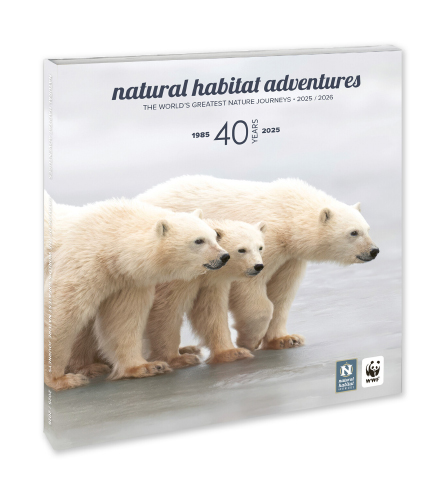Orcas are among the ocean’s most intelligent and social predators, captivating us with their strong family bonds, advanced hunting strategies, and cultural behaviors. Found in every ocean, they play a vital role in marine ecosystems and are a powerful symbol of ocean health. Yet many orca populations face mounting threats that demand urgent action.
Quick Orca Facts
- Size: Males typically range from 20 to 26 feet (6 to 8 meters) long and weigh in excess of 6 tons. Females are smaller, generally ranging from 16 to 23 feet (5 to 7 meters) and weighing about 3 to 4 tons. Larger male orcas have been recorded at up to 32 feet and over 10 tons.
- Habitat: Found in every ocean, from polar waters to tropical seas, orcas clearly demonstrate a preference for coastal environments over the open ocean. The highest densities of orcas are in the northeast Atlantic around Norway, in the north Pacific along the Aleutian Islands, the Gulf of Alaska and in the Southern Ocean off much of the coast of Antarctica.
- Diet: Includes a growing number of types of fish, seals, and whales, with hunting methods passed down culturally.
- Social Structure: Live in pods with strong bonds and unique vocal dialects.
- IUCN status: Data Deficient on the IUCN Red List of Threatened species
In this article, we’ll dive into four extraordinary orca stories, showcasing their hunting habits, social structures, and remarkable ways they adapt to a changing world.

1. Do Orcas wear salmon hats?
In late 2024, a photo of an orca swimming with a salmon on its head went viral, reigniting interest in a quirky behavior first documented in the 1980s: orcas wearing “dead salmon hats.”
This unique trend, originating among the critically endangered Southern Resident orcas in the Pacific Northwest, involved balancing dead fish on their heads. Initially, the behavior spread across pods but disappeared within a few years. The recent image, published by the Orca Network, sparked speculation that the trend was making a comeback, but experts remain skeptical.
Salmon Hat Orca Sightings
- Two observations of orcas with fish on their heads were reported in Washington State in South Puget Sound and off Point No Point in late October 2024.
- The Orca Network, a nonprofit dedicated to killer whale education, captured and shared one of these sightings in their newsletter, fueling public fascination.
Where is the Salish Sea?
- The Salish Sea, named after the first inhabitants of the region – the Coast Salish – includes the Puget Sound, San Juan Islands and the waters off the coast of Vancouver, British Columbia. The area spans from Olympia, Washington, in the south to the Campbell River, British Columbia, in the north, and west to Neah Bay.

Do scientists believe salmon hats are back?
- Scientists have commented that it is a stretch to interpret two incidents as a revival of the salmon hat fad, emphasizing that if the behavior were widespread, it would have been documented more extensively, given the high levels of observation of the Southern Resident orca population.
The 1980s Origin of the Salmon Hats Fad
- In the 1980s, the dead salmon hat trend began among the Southern Residents before spreading to other pods in the Pacific Northwest. It quickly faded and had not been observed for decades until these recent sightings.
- Some experts remain cautious about declaring the return of the fad, but marine mammal experts acknowledge that orcas, like humans, engage in complex cultural behaviors. Whether it’s dragging seaweed in “kelping” or investigating floating objects, these interactions highlight the intelligence and adaptability of orcas.
Despite the excitement surrounding the salmon hat sightings, scientists stress the need for a broader understanding and conservation of the critically endangered Southern Resident Salish Sea population, numbering just 73 individuals as of 2024.

Two of our trips offer an opportunity to see Southern Resident orcas:
- Spirit Bears, Humpbacks & Wildlife of British Columbia
- Haida Gwaii: Islands at the Edge of the World
2. Orcas Add Whale Sharks to Diet Using Novel Techniques
Orcas are known for their diverse diets and advanced hunting strategies, and the next two stories highlight previously unobserved hunting strategies in orca populations in two different parts of the world.
In the first, orcas in Mexico’s Gulf of California have added an extraordinary target to their menu: whale sharks, the largest fish in the ocean. Whale sharks can grow up to 60 feet long,
A recent study in Frontiers in Marine Science details how orcas in the Gulf of California have developed unique techniques to hunt the marine giants.
Between 2018 and 2024, marine biologists documented four instances of orcas preying on whale sharks in the southern Gulf of California. These events were captured in photographs and videos by scientists and members of the public.

Collaborative Orca Hunting Tactics
- Orcas target juvenile or smaller whale sharks, often found in specific Gulf locations.
- The hunting pod flips the shark upside down, inducing tonic immobility—a state where the shark becomes paralyzed and defenseless.
- Once immobilized, the orcas attack the shark’s ventral side, where muscle and cartilage are minimal, allowing access to vital organs like the lipid-rich liver.
Notable Orca Individuals
- A male orca nicknamed Moctezuma was present in three of the four recorded hunts, often accompanied by a female from his pod.
- These repeat sightings suggest that certain orca pods may specialize in hunting whale sharks, indicating learned or cultural behavior.
Scientific Implications
- Whale shark livers are highly nutritious. Several of the orcas were observed with whale shark carrion in their mouths during an attack on May 26, 2024
- The documented events suggest that orcas in the Gulf of California have developed region-specific and collaborative skills, though similar behaviors may exist elsewhere and remain undocumented.
The orcas’ strategic and intelligent hunting of whale sharks offers a glimpse into their adaptability and reinforces their status as apex predators. These findings deepen our understanding of orca behavior and stress the importance of protecting both orcas and their prey to maintain oceanic balance.

3. Shark-Hunting Orca Pair off the Coast of Southern Africa
If orcas in the Gulf of California are practicing hunting larger prey, a duo off Southern Africa has mastered it.
In June 2023, researchers and tourists off the South African coast near Seal Island, Mossel Bay, observed a groundbreaking event: a single male orca killed a great white shark in under two minutes.
The behavior, documented in the African Journal of Marine Science, challenges conventional understanding of orca hunting dynamics and ecosystem health.

Port and Starboard: Shark-Hunting Specialists
A pair of male orcas have been killing sharks along a stretch of southern African coastline since at least 2015, expertly removing the sharks’ nutrient-rich livers and discarding the rest. The duo is easily identifiable by their distinctive collapsed dorsal fins—one tips to the right, the other to the left – inspiring their names: Starboard and Port.
Starboard and Port were first spotted off the coast of southern Namibia in 2009. They travel vast distances, from Namibia south, around the Cape of Good Hope, into False Bay, and then on to South Africa’s eastern coastline. And they leave a wake of shark carcasses with their livers removed, including a great white up to 16 feet long.
Prior to 2015, scientists believed orcas in the False Bay area only preyed on marine mammals; Port and Starboard began hunting copper sharks and ocean sunfish right away.
Then, they started attacking alone.
Starboard was first filmed via drone, killing a great white in May 2022 around Mossel Bay, South Africa, alongside four other orcas. After the attack, great white sharks fled the area for at least seven weeks.
On February 24, 2023, Port and Starboard killed 17 sevengill sharks in a single day off the coast of Pearly Beach. Every one of their livers had been precisely removed.
In June 2023, scientists and visitors in boats observed Starboard killing a great white shark. It was the first recorded instance of an orca attacking a great white shark alone.
Previously observed attacks on great whites involved between two and six orcas and took up to two hours, according to the study. Starboard removed the shark’s liver in under two minutes.

Ecological and Environmental Implications
Selective Feeding Behavior
The livers of great whites are enormous organs, about a third of their body mass, and rich in lipids, and the orcas discard the rest of the carcass — selective feeding behavior that’s known among other carnivores, such as harbor seals, brown bears and wolves.
Broader Ecosystem Dynamics
There are a lot of unknowns about the orcas’ behavior. One thing is certain: The orcas are scaring off shark populations, which could have cascading negative effects on marine ecosystems.
Before 2015, False Bay was known for its large population of great white sharks; by 2020 sightings were reduced to nearly zero. Scientists are increasingly concerned for the coastal marine ecology balance; local businesses are concerned about the loss oof reveu from cage diving and opportunity to see unique breeching sharks.
As great whites are top predators, their absence may lead to population increases in mid-level predators, potentially disrupting prey populations and biodiversity of the local ecosystem; sharks serve as the main predators of Cape fur seals.
Orcas have long been recognized for their ability to learn and refine hunting techniques, either independently or through cultural transmission within pods. This adaptability enables them to respond to changes in their environment, underscoring their role as apex predators with profound ecological influence.
As their IUCN Data Deficient designation denotes, we do not know enough about orcas and their ecosystems. Researchers around the world aim to change that.

4. Orca Research: Drones Unlock New Conservation Frontiers
Back at the Salish Sea, scientists are racing to improve conservation efforts for this critically endangered orca population.
A groundbreaking project is using drones to collect and analyze orca breath, a non-invasive technique that offers critical insights into the whales’ health and environmental stressors.
The project was inspired by Scarlet, a Southern Resident orca who died in 2018. Despite visible signs of illness, researchers were unable to diagnose her condition in time to save her. Scarlet’s loss highlighted the urgent need for non-invasive, real-time health assessments for wild whales.
How Orca Breath Sampling Works
- Exhaled breath contains vital information, including hormones, bacteria, viruses, and other biomarkers that can reveal an individual whale’s health and overall population trends.
- Early detection of illnesses allows scientists to intervene before health issues become critical, potentially improving survival rates for vulnerable individuals.
- The ability to track health trends over time could revolutionize conservation strategies, making real-time, non-invasive orca veterinary assessments feasible.
- This approach is challenging; aligning the drone with a moving orca’s blowhole requires precision akin to solving a complex geometry problem.
- Scientists process the data to identify health indicators, track changes over time, and understand potential stressors impacting the population.

Challenges and Benefits of Monitoring Orca Breaths
Analyzing and interpreting complex health data from orca breath samples is a developing science, but by identifying health problems in their early stages, scientists can develop targeted conservation interventions.
This is particularly critical for the Southern Resident population, which faces numerous threats, including:
- declining prey availability,
- pollution, and
- noise disturbance from increased maritime activity.
The success of this program could serve as a model for other whale populations worldwide, offering a scalable approach to marine mammal conservation.
The orca breath project demonstrates how innovative technology can advance wildlife conservation. While the Southern Residents remain critically endangered, this hands-off approach provides hope for preserving the iconic pod. By unlocking the secrets of their breath, scientists are better equipped to understand and address the challenges they face, ensuring the survival of these extraordinary creatures for future generations.

Orca Conservation Considerations
Orcas face a host of threats, including:
- habitat degradation,
- declining prey populations,
- pollution, and
- climate change.
These may account, in part, for novel and changing behaviors.
Despite challenges, recent scientific studies and real-world encounters reveal the incredible resilience and complexity of orcas. From ingenious hunting techniques to groundbreaking research on their health and behavior, it’s clear we still have a lot to learn about orcas and the coastal ecosystems in which they live.




























